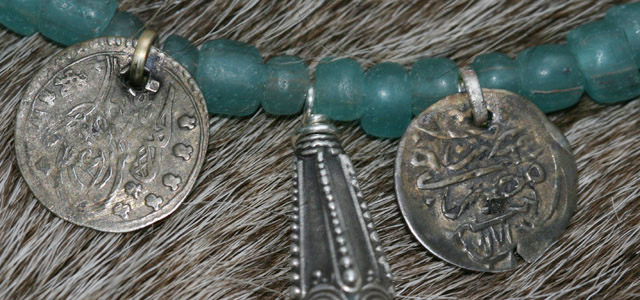One
would hardly look at the Vikings as an example of a sustainable
culture - the common view of Vikings is that of pillagers and
destroyers, not the kind of considerate and responsible lifestyle
generally associated with sustainability.
 However,
some early examples of the circular economy were already
well-established practices with the longboat-sailing and axe-wielding
wild men best-known for the sack of Lindisfarne. The exhibition
'Vikings - life and legend' that opened this week at the British
Museum showcases Arabian dirhams remanufactured into jewellery
a reliquary stolen from a monastery reused by a Viking lady who
inscribed her name in runes in the bottom, and worn bracelets chopped
up and recycled as bullion.
However,
some early examples of the circular economy were already
well-established practices with the longboat-sailing and axe-wielding
wild men best-known for the sack of Lindisfarne. The exhibition
'Vikings - life and legend' that opened this week at the British
Museum showcases Arabian dirhams remanufactured into jewellery
a reliquary stolen from a monastery reused by a Viking lady who
inscribed her name in runes in the bottom, and worn bracelets chopped
up and recycled as bullion.
Yes,
I trained as an historian before becoming an environmental
professional. So it's fun to be able to join the perspective of the
former with the latter.
So much for the past - back to our times
Together
with approximately 11,000 other visitors, I spent a couple of days in
London at Resource http://www.resource-event.com/, which claims to be
the first event on the circular economy ever organised in the UK. It
brought together an inspiring mix of people from all around the
Circular Network: manufacture, retail, recycling business, social
enterprises, charities and network organisations, consultancies,
universities and regional governments.
looking after it for the next generation
The
organisers had brought on some thought-provoking speakers. I listened to Sir
Ian Cheshire, from the DIY retail company Kingfisher, who expressed a
strong belief that anybody's business can be reinvented to fit into
the circular economy; James
Woudhuysen, who claimed that there was no resource shortage. He
failed to persuade us that the circular economy was humbug, as he
chose to ignore UN, OECD, WRI data all pointing in another direction; and Walter
Stahel, who used his 30-year-old Toyota as an example of how the
circular economy could work.
Contrary to what I thought, a
refurbishment of an old car will lead to a reduction of GHG
emissions, as well as a reduction in waste. Another example he used
was that of the Patek Philippe watchmakers, who claim: 'You never
actually own a Patek Philippe. You merely look after it for the next
generation'. Such a watch, by the way, will cost you at least half a
year's salary. Stahel also mentioned the Pont de Millau, which
had been procured in 2001 with a 78-year contract that included
design, financing, building and operation of the bridge. The bridge
is practically maintenance-free. The crucial part of the development
of the circular economy to Stahel was its emphasis on performance.
remanufacturing
Remanufacturing
turns out to be something that is already happening on a substantial
scale in the business-to-business part of the value chain, and in
very specialist niches of public procurement. For instance, at the
expensive end of the automotive industry (Rolls Royce), and with the
military. High-end investments in equipment keep their value, so
replacing components, engines or spare parts easily makes sense. At
the same time, the suppliers are specialised so there is little
competition, and finally, there are trustworthy quality standards in
place.
This
serves to point out under what conditions the broadening of
remanufacturing to less specialised markets could take place:
ensuring quality and reliability is key.
vibrant new aesthetics
'Vibrant
new aesthetics are coming into existence - sustainable design is
colourful and witty', said Clare Brass, tutor of innovation design
engineering at the Royal College of Art. The role of design was
generally acknowledged as a very important one in the whole value
cycle making up the circular economy. Redesigning products for
recycling, remanufacturing and reuse, but also redesigning as part of
a transition to business models centred around services rather than
products.
social enterprise
Notably,
many of the people I spoke with saw the Netherlands as leading the
way in achieving the circular economy. The UK is indeed late in
taking up recycling, and the path it has chosen in collecting mixed
packaging from households is open to criticism. However, on the
upside, the UK is highly effective in promoting relatively new forms
of business within the CE in the shape of networks and social
enterprises. These are catching on at an incredible speed. Examples
include the Restart project, a charity that helps you repair your ICT
items, Rentez-vous, a fashion rental
company, the Goldfinger Factory that turns your
boring old stuff into gold, London Re-use, a network of outlets for repaired household items similar to
the Dutch 'kringloopwinkels'.
enabling
In
a workshop I attended, we discussed what was hampering the circular
economy. Beside attitudes and assumptions about reuse, recycling and
remanufacturing, several people in our group voiced the lack of
flexibility in EU competition and procurement legislation, which was
seen to stand in the way of working together in networks with other
companies. As network organisation is really at the core of the
circular economy, this needs to be brought to the attention of
legislators. Maybe some room for experiment can be created at least.
This
year's event acted as a launch pad; next year, the organisers promise
something bigger. Dates already announced: 3-5 March 2015.
Back to my website: Foxgloves.eu
Back to my website: Foxgloves.eu
